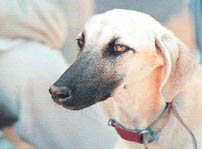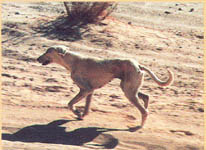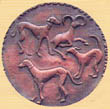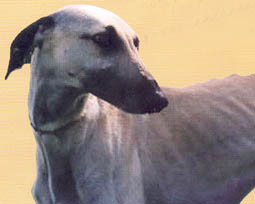With the utmost grace and balance, almost flying through the
air with their feet merely skimming the ground, the Saluki dog is also known as "The
Royal Dog of Egypt". The Pharaohs selectively bred them to hunt gazelle, naming them
after an Arabian city in the Middle East which has long since vanished beneath the sands.
In fact even earlier than this, when man first tried to domesticate the wolf, they gave us
the Saluki as the first dog. The distinctive Saluki shape can even be seen in carvings
dating back to 14,000 BC and, when the bible speaks of dogs, it means the Saluki.
Standing proudly at 70 cm and weighing around 25 kg, the Saluki
has the appearance of a greyhound on speed, easily cruising along in excess of 50 kph over
long distances. Unlike the greyhound and the whippet, they were bred for stamina and
endurance as well as acceleration. Their long distance eyesight is exceptional, and
evolution and breeding have provided them with deep chests, allowing plenty of room for an
abnormally large heart and lungs with which to provide sufficient air and blood for the
chase. Their long slender legs are less fragile than they might appear, and are like
coiled springs for maximum acceleration. Their bones are light, tough and bladed rather
than heavy and round, designed by nature for one specific task: - to carry those strong
but elegant jaws swiftly to their prey. Even their long tails act as a lightweight rudder
during high speed turns.
Their feet, thickly feathered between the toes, enable them to run
in deep sand. Also, in order to survive the heat of the desert, they are the only breed of dog with
a single layer coat. This has the useful side effect that they never smell, very
beneficial when you’re sharing your tent with one. There are two types of this coat,
either feathered or smooth, differentiated by the amount of hair on their long tails, legs
and ears. These coats come in combinations of tan, reddish brown and white. The lighter
shades blend well with the southern desert lands, whilst the darker varieties are limited
to the North. Hunting in packs and away from the direct supervision of their owners, they
are prized not only for their speed, grace and physical prowess but also for their
intelligence. The favourites, the bitches, are the most aggressive hunters, the more pack
orientated and the cleverest.
breed of dog with
a single layer coat. This has the useful side effect that they never smell, very
beneficial when you’re sharing your tent with one. There are two types of this coat,
either feathered or smooth, differentiated by the amount of hair on their long tails, legs
and ears. These coats come in combinations of tan, reddish brown and white. The lighter
shades blend well with the southern desert lands, whilst the darker varieties are limited
to the North. Hunting in packs and away from the direct supervision of their owners, they
are prized not only for their speed, grace and physical prowess but also for their
intelligence. The favourites, the bitches, are the most aggressive hunters, the more pack
orientated and the cleverest.
 Their original owners, rich and royal men mounted on the finest Arabian
horses, would ride out into the desert and release the hawks held proudly on their wrists.
These hawks would find a herd of Gazelle and circle around it in the sky, whereby the pack
of Saluki would be released to chase and capture a victim, hold it down but not kill it.
In Islam, the hound must not kill the prey or its meat cannot be consumed. Due to this
decree, the Saluki were trained to hold the throat, cutting of the oxygen supply, thus
rendering them unconscious to await the brave hunters knife. If the hunt was for hares,
the Saluki would bring them back unmarked and alive. Sometimes the chase was short and
fierce but it usually lasted for many miles, testing the stamina and heart of the Saluki.
Their original owners, rich and royal men mounted on the finest Arabian
horses, would ride out into the desert and release the hawks held proudly on their wrists.
These hawks would find a herd of Gazelle and circle around it in the sky, whereby the pack
of Saluki would be released to chase and capture a victim, hold it down but not kill it.
In Islam, the hound must not kill the prey or its meat cannot be consumed. Due to this
decree, the Saluki were trained to hold the throat, cutting of the oxygen supply, thus
rendering them unconscious to await the brave hunters knife. If the hunt was for hares,
the Saluki would bring them back unmarked and alive. Sometimes the chase was short and
fierce but it usually lasted for many miles, testing the stamina and heart of the Saluki.

It’s unusual for a dog to be prized in Arabia, but the Saluki
were originally only available to the nobility and never for sale, just very occasionally
offered as a prized gift. Many have been found mummified with their owners and they had
the rare distinction, for a dog, of being allowed to sleep inside. This special treatment
may be due to the patch of white in the middle of their foreheads, thought by the Bedouins
to be the "Kiss of Allah". For many centuries the nomadic Bedouin have been
depending on the Saluki to chase game for the tribes cooking pots. More recently, both the
Bedouin and the Saluki are being crowded out by the steady ingress of civilisation. As
these once free nomads cease roaming the open desert and move into concrete cities, the
need for a hunting dog becomes swiftly overshadowed by the need for a mobile phone.
 breed of dog with
a single layer coat. This has the useful side effect that they never smell, very
beneficial when you’re sharing your tent with one. There are two types of this coat,
either feathered or smooth, differentiated by the amount of hair on their long tails, legs
and ears. These coats come in combinations of tan, reddish brown and white. The lighter
shades blend well with the southern desert lands, whilst the darker varieties are limited
to the North. Hunting in packs and away from the direct supervision of their owners, they
are prized not only for their speed, grace and physical prowess but also for their
intelligence. The favourites, the bitches, are the most aggressive hunters, the more pack
orientated and the cleverest.
breed of dog with
a single layer coat. This has the useful side effect that they never smell, very
beneficial when you’re sharing your tent with one. There are two types of this coat,
either feathered or smooth, differentiated by the amount of hair on their long tails, legs
and ears. These coats come in combinations of tan, reddish brown and white. The lighter
shades blend well with the southern desert lands, whilst the darker varieties are limited
to the North. Hunting in packs and away from the direct supervision of their owners, they
are prized not only for their speed, grace and physical prowess but also for their
intelligence. The favourites, the bitches, are the most aggressive hunters, the more pack
orientated and the cleverest.  With the utmost grace and balance, almost flying through the
air with their feet merely skimming the ground, the Saluki dog is also known as "The
Royal Dog of Egypt". The Pharaohs selectively bred them to hunt gazelle, naming them
after an Arabian city in the Middle East which has long since vanished beneath the sands.
In fact even earlier than this, when man first tried to domesticate the wolf, they gave us
the Saluki as the first dog. The distinctive Saluki shape can even be seen in carvings
dating back to 14,000 BC and, when the bible speaks of dogs, it means the Saluki.
With the utmost grace and balance, almost flying through the
air with their feet merely skimming the ground, the Saluki dog is also known as "The
Royal Dog of Egypt". The Pharaohs selectively bred them to hunt gazelle, naming them
after an Arabian city in the Middle East which has long since vanished beneath the sands.
In fact even earlier than this, when man first tried to domesticate the wolf, they gave us
the Saluki as the first dog. The distinctive Saluki shape can even be seen in carvings
dating back to 14,000 BC and, when the bible speaks of dogs, it means the Saluki.
 Their original owners, rich and royal men mounted on the finest Arabian
horses, would ride out into the desert and release the hawks held proudly on their wrists.
These hawks would find a herd of Gazelle and circle around it in the sky, whereby the pack
of Saluki would be released to chase and capture a victim, hold it down but not kill it.
In Islam, the hound must not kill the prey or its meat cannot be consumed. Due to this
decree, the Saluki were trained to hold the throat, cutting of the oxygen supply, thus
rendering them unconscious to await the brave hunters knife. If the hunt was for hares,
the Saluki would bring them back unmarked and alive. Sometimes the chase was short and
fierce but it usually lasted for many miles, testing the stamina and heart of the Saluki.
Their original owners, rich and royal men mounted on the finest Arabian
horses, would ride out into the desert and release the hawks held proudly on their wrists.
These hawks would find a herd of Gazelle and circle around it in the sky, whereby the pack
of Saluki would be released to chase and capture a victim, hold it down but not kill it.
In Islam, the hound must not kill the prey or its meat cannot be consumed. Due to this
decree, the Saluki were trained to hold the throat, cutting of the oxygen supply, thus
rendering them unconscious to await the brave hunters knife. If the hunt was for hares,
the Saluki would bring them back unmarked and alive. Sometimes the chase was short and
fierce but it usually lasted for many miles, testing the stamina and heart of the Saluki.
